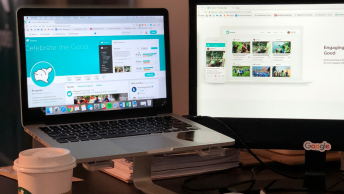An editorial calendar is a great addition to any content creating aspect of your business. With 7 easy steps, you can completely organize and effective editorial calendar.
With an editorial calendar being created and used, you put your business on the path to digital branding success by synchronizing all of your efforts.
7 Steps to Creating and Executing an Editorial Calendar
Having a content calendar will take care of all the pressing questions that come with starting a blog. How can I create so much content? How do I manage deadlines? How do I stay focused? How do I make sure my employees are informed enough to be able to help me?
This is where your editorial calendar swoops into the rescue, ready to answer all your questions and be a great solution for your business.
Why Develop an Editorial Calendar?
An editorial calendar is a great way to make sure that all of your goals are met and kept organized. It is a great area where you can focus on your goals. Do this by making sure that all of your content is focused on where you want to end up instead of being aimless.
An editorial calendar also gives clear deadlines. Articles will be written when they are supposed to because they have been thought out and planned.
An editorial calendar ensures that content will be executed consistently.
When shared with a team, an editorial calendar can also unite other business areas of your brand. It puts everyone on the same page concerning what the company is about and what you’re trying to achieve.
Step 1: Define Your Strategic Objectives
When you start planning out your editorial calendar, it is important to keep your goals physically in front of you. This will ensure that you stay on track with your goals while you plan.
Your strategic objectives are what drives your content topics. Without a clear definition, your content can seem aimless and may not be useful to your customers.
If your brand deals with several different customer segments, this is the time to narrow that down. Focus on one segment when planning your articles so that you can meet the needs of your customers without falling short or overwhelming them.
Reduce the complexity of your calendar and create a consistent objective.
In her award-winning book, “The Unbreakable Rules of Marketing,” expert marketing strategist Cathey Armillas states one unbreakable rule is consistency. “Over the long term, a company that is consistent with its marketing message is going to whip a competitor that is inconsistent with its message, even if each of those inconsistent messages are compelling, creative, clever, or even superior,” she says.
Step 2: Focus On Customers While Planning
When you’re writing, you need to know who your customers are. Know what they would say and how they would think.
A great way to do this is to develop a customer persona. This is a detailed description of a fictional person who would buy your products. Having a customer persona takes you past simple demographics and gets into the depth of your customer. It will help you to know what they think, what they value, and how they make decisions.
It is useful also to consider what kinds of articles your consumers would like to read. Once you know your customer, you can write the information they are looking for. This will focus your content better and give you a specific clientele that matches your brand.
SEE ALSO: How to Use User Generated Content to Build Your Digital Brand
Step 3: Identify Anchors in Your Editorial Calendar
Your anchors are your big deal time periods. These are things like major industry events, the start and end dates of a buying season, time periods, and product launch dates.

Once you have these dates in your head, you need to put them down on your calendar.
Having your anchors thought out ahead of time will allow you to plan for them. You won’t have to worry about running out of time or resources for your important dates because they will already be incorporated into your calendar.
You will need lots of content built up in advance for these time periods, so putting them down on your calendar early will ensure that you create excellent content earlier than you would have otherwise.
Step 4: Begin Developing a Publishing Schedule
The suggested outline for your publishing schedule is:
- 1-2 blog posts a week
- 1-3 social pushes for your content
- this is how many times you mention your content on social media
- one guide or trend report every quarter
- one eBook a year
- one email newsletter a month
- this should be primarily full of your blog posts or articles
Remember, this is just a good beginning publishing schedule. Your customer persona may require or want something different. Evaluate what your customer will want and what works best with your schedule.
You don’t have to follow our guidelines exactly to find success, but it should make you think about what is necessary for your brand. Think seriously about how much content you want to create when you’re first starting and go from there.
An important reason for planning things out so specifically is to make sure that your team works well together and avoids petering out after your initial launch.
What I fear for newbies starting that way, especially when working with a team new to blogging, is that there is tons of room for burnout by publishing too much content too quickly. Instead, in the first months especially, focus on publishing enough content to work through the awkward newness of blogging, without overwhelming your team. –Nathan Ellering of CoSchedule Blog
It is also good to remember to plan out at least three months at a time when creating your editorial calendar.
Step 5: Map Out Your Content Sources
This is where you decide where to pull information from. There are a few different sources you should consider when writing your articles.
1. Internal Sources
- Your company will have awesome people full of interesting perspectives on different topics. They are also, more likely than not, fully capable of writing on certain subjects.
- Just be sure to have a conversation to know what your writer is thinking about and make sure everyone is on the same page.
- Remember that frontline employees deal with customers on a consistent basis will have a great idea of what the person you’re targeting will want to read.
2. External Sources
- This is where it’s important to set aside additional funds to create content.
- Freelance writers, agencies, or other partners can be hired to create more content for your brand.
3. Customer Advocates
- Sourcing your content to your customers can be a great way to develop content.
- Afterall, who knows better what your customers are thinking or wanting than your customers?
4. Repurposed Marketing Material
- Use an old blog post, video, or guide to fill in the gaps in your content.
- These are great resources that can be used again because they fill a need.
SEE ALSO: How to Create a Social Content Strategy for Your Brand
Step 6: Manage Your Editorial Calendar
No matter what medium you use for your editorial calendar, whether it be a spreadsheet, piece of paper, or software application, it is important to keep an eye on it and use it after you’ve created it.
Three different labels are essential when using your planned out editorial calendar: assigned, work in progress (WIP), and complete. Highlighting these labels with different colors will help you know exactly where each article is on the path to publication.

Adding a content brief to each article can also be a great way to manage your editorial calendar. A content brief should include the background of the post, who the post is for, what the big idea of the piece is, what the call to action should be, what extra resources are necessary, and what the end word count is.
SEE ALSO: Content Planning Tips To Compete with Big Brands
Step 7: Sell Your Editorial Calendar to Your Executive Team

This is where you get the rest of the team on board with using your editorial calendar. When talking to your executives, be sure to talk to them about the problem as much as the solution. Make sure that you sell the problem because executives are only interested in spending time and money on plans that solve legitimate problems.
Executives will love that editorial calendars are built with strategic objectives and that your plan aligns perfectly with strategic objectives. Tracking and performance feedback is built in so that it can be optimized and improve over time. These are clear benefits for your editorial calendar.
Final Thoughts
Implementing an editorial calendar into your brand can have awesome results for your blog. By planning everything out according to your timeline and knowing exactly who you are and who you want to appeal to, your posts will be timely and informative.
An editorial calendar can be the solution to timing problems and can clue in all of your staff to exactly the kind of content you want to be known for. In essence, an editorial calendar solidifies your digital brand for you.
What to do feel is more important today: planned content or ‘real-time’ content?











